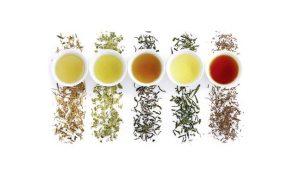Discovered 5000 years ago!
Originally tea comes from China. It is estimated that the tea plant was discovered there almost 5000 years ago. This was a well-kept secret for a long time because it was not until 700 AD that tea was grown in Japan.
In the 17th century in Europe
The first tea boxes finally arrived in Europe at the beginning of the 17th century with the merchant fleets of the Dutch and British colonial rulers. Tea is prepared mainly from the uppermost leaves and leaf buds of the tea plant, which belongs to the genus of the camellia family. It likes to grow wherever the climate is humid and warm.
China, India, Sri Lanka, and Kenya
The main growing areas are China, India, Sri Lanka, and Kenya. After picking, which happens in most cases by hand, the tea leaves are withered, rolled, fermented, dried, and sorted. In contrast to coffee, which is carried out in raw form, the tea leaves are already processed on the plantations and exported as finished tea. Generally, tea is divided into four types: green tea, white tea, and oolong tea, each of which is infused with about 80 ° C of hot water, and black tea, for the preparation of which boiling water is used to achieve full flavor development.
There are countless varieties per tea species, e.g. Assam and Darjeeling (both black teas) or Sencha (green tea). In the German language, they also describe tea-like infusion drinks such as herbal tea, fruit tea, and Rooibuschtee as tea. Also common are flavored teas, smoke teas, or roasted teas. Tea is mainly consumed in the form of loose tea leaves or as a portioned tea (tea bag), more rarely as a powder or in a compressed form.
The trade names
In the trade a number of names are common, in addition to the type of tea also provide information about the leaf size and appearance of the leaves: orange, pekoe, broken, fannings, or dust. This results in abbreviations such as FOP, TGFOP, and BOPF, which as well as the notes “First Flush” (first harvest in spring) and “Second Flush” (second harvest at the end of May) function as quality terms.
Recent Posts
Ulrich’s GAProductions
The Dinosaur Eye – Wall Art
Get your Wall Picture here Read More
Hot Chocolates Restaurant and Nite Club
All your Traveling needs here at Amazon Read More
My Cosmopolitan Magazine modeling Days😁
Ulrich’s Miami Mob ordeal Read More
Ulrich’s Hot Chocolates, Fort Lauderdale, Florida, 1997 – 2001
Hike to Lake Tremorgio, Ticino, Switzerland
Daniel Humm is revolutionizing 3-Star Cuisine
This is how the first vegan menu tastes in “Eleven Madison Park” in New York... Read More
Swiss Travel Soothing Music Video
Ulrich’s Guadalajara & Mexico City Experience
Chef Ulrich in Action in Guadalajara, Mexico My first visit to Mexico was with my... Read More
Chef UlrichK on Selkirk CH.13 Cooking Show
My awkward Brandy bottle pop! The video is 16 min. long – Video is 37... Read More
Ulrich in the Dominican Republic
In 1987 I arrived in Santo Domingo to work on the re-opening of the new... Read More
Ulrich’s Miami Mob ordeal
As a Swiss chef, I took the opportunity to go and see the world, that... Read More
Exciting Swiss Family Koepf Hike to 2300 m
The Bristen (3073m) is a mountain in the Canton of Uri, Central Switzerland. ... Read More
Around Monte Baldo, Italy
On my recent visit to Verona, I came across these amazing places; situated in the... Read More
Subscribe here
Click here to Subscribe Read More
Aquaria, Thermal Waters of Sirmione
The Uniquelness of our Thermal Water Click here to visit the website The... Read More
In a MOOD for Sushi?
I am not a fan of raw fish, I like my fish cooked, especially knowing... Read More